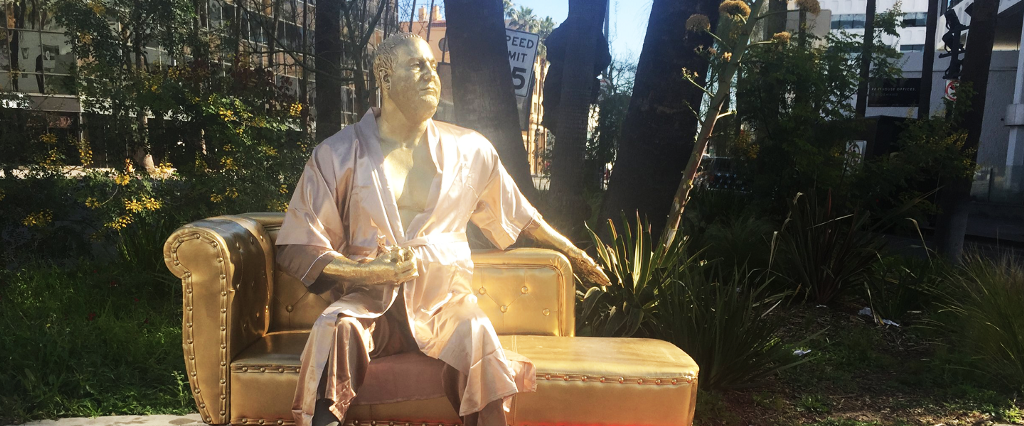By the time the Oscars red carpet broadcast started on Sunday night, the statue of a gold, be-robed Harvey Weinstein was gone. The creators, street artists Joshua “Ginger” Monroe and Plastic Jesus, had removed it on Friday due to rain — apparently, the piece wasn’t built to withstand the elements — and never bothered to put it back on display. By Sunday then, the environs surrounding Hollywood Boulevard had returned to their usual order — tourists wandering around aimlessly, their heads fixed on the ground, staring at the stars on the Walk of Fame.
That, of course, is a shame, because the statue would’ve been especially poignant on Oscar night — an evening Weinstein used to own. Instead, the only protest taking place in the area was a group of Korean-Americans opposing U.S. military involvement in the region.
Erected last Thursday, mere blocks from the Dolby Theatre, where the Oscars are held every year, the statue was intended to serve as an uncomfortable reminder of Weinstein’s serial sexual abuse and harassment, and the industry code of silence that provided cover for him for decades. Not exactly subtle, it showed a half-naked Weinstein in his signature slovenly appearance — his face pock-marked and bloated, his robe barely covering his potbellied stomach. In his right hand is an Oscar statue positioned where his penis should be. And he sat atop the proverbial casting couch, the place where so many wannabe Hollywood starlets are pressured to exchange sex for sudden fame.
Ginger and Plastic Jesus wanted passersby to sit next to Weinstein, to experience his gaze and to be within his grasp — and then post their experience to social media. (This is a regular gig for Plastic Jesus, who fucks with Hollywood every year around Oscar-time: “For the past 4 years, I have created an alternative Oscars statue to highlight issues that often go unnoticed in the glitz and glamor of Hollywood, these have included drug addiction, hero worship and exploitation,” he wrote recently on Instagram.)
https://www.instagram.com/p/BelAbX2FJy_/?hl=en
I understood the sculpture as an art piece — it was expert trolling of Hollywood’s hypocrisy with the respect to the #MeToo movement. But I was particularly interested in the people who posed with it, curious as to what kind of statement they were hoping to make by placing it in their Instagram feed — and how they felt in the presence of such an over-the-top visage of our current moment’s biggest monster.
In the 24 hours or so that the statue was up, it definitely didn’t go ignored, with numerous locals and visitors alike seeking it out and documenting their interaction with it on social media — from the profound to the cringeworthy.
“Some people were sitting next to the statue, and putting their arms around Harvey, and I thought that was kind of obtuse,” says 58-year-old Gregg Donovan, the self-proclaimed “Ambassador of Hollywood,” who works on Hollywood Boulevard each day, marketing bus tours to tourists. “I thought, Why? What’s the reason? I don’t think they realize the implication.”
Indeed, there was something vaguely unsavory to me about posting selfies with the piece — something about playing the whole thing for Instagram likes that distracts from the gravity of Weinstein’s wrongdoing.
Donovan and I seemed to be in the minority, though. “For me, posing with it is a way to show how much of a joke Weinstein now is,” explains Chris Kwon, a 32-year-old who works at a digital media production office near where the statue was located. “We’re not putting the victims down. We’re pointing out there is this terrible person in the society — and that if you behave the way he did, you will forever be remembered as a punchline.”
In his Instagram photo, Kwon leans aways from the gilded Weinstein, seemingly trying to avoid the disgraced movie producer’s lascivious grasp, and making a disgusted face. He punctuates the post with the hashtag #nutstomp.
For her part, Sarah Joy Allison, a 37-year-old street art enthusiast, sidled up right next to Weinstein, placing her hand on his knee. She felt like it was a way to face down power that went unchallenged for far too long. “It’s like, Weinstein is here, out of the shadows. And it’s so shiny. Let’s deal with the reality of who he is,” she says. “The statue is an important statement, and I’m happy to do anything to support it.” (“I hope you get the part,” reads one of the comments of her post.)
“The statue was a much more emotional experience for the women there,” Kwon says of the people he encountered on Thursday. “They were telling me about all the emotions this man evoked in them — feelings of disgust and anger.”
The best example of what Kwon is talking about is probably the trio of women who posed with the statue making the speak-no-evil, hear-no-evil, see-no-evil gestures:
There were no such poses on Sunday afternoon, though — no nut stomps; no hands on knees; no disapproving, Ebert-esque downward turned thumbs; and no women commenting on the blissful ignorance in Hollywood that allowed Weinstein to operate for so many years. Far as I could tell, none of the people walking where the statue had been were aware it had ever even been there in the first place.
Instead, they were taking photos with a different statue in the area — a piece called the Hollywood and La Brea Gateway, but better known by its colloquial name, the Four Ladies of Hollywood gazebo.
Standing at the westernmost end of the Hollywood Walk of Fame, the monument shows four nearly nude women holding up a domed, lattice structure. The piece is topped by an obelisk, with “Hollywood” written on its four sides in neon, block letters. And at its very top is a small statue of Marilyn Monroe in The Seven Year Itch, trying to prevent her dress from billowing up.
Like I said, the usual order had been restored.
